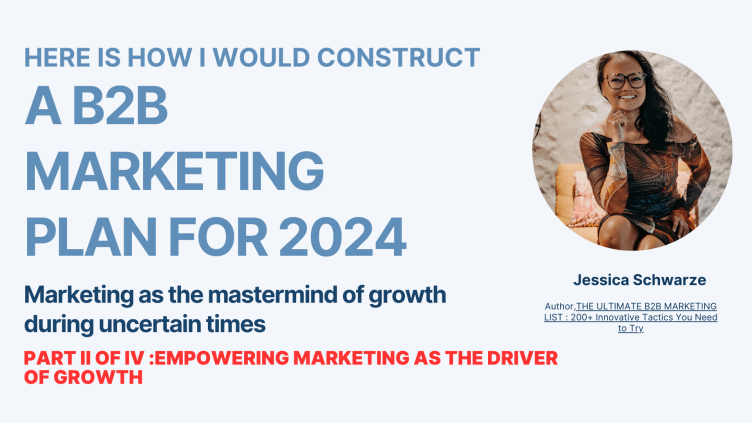After the first part of this article series on Marketing Planning for 2024, where I spoke of foundational considerations, I am pleased to present the second part. This time we look into empowering Marketing as the Driver of Growth in 2024. What should constitute essential parts of the plan? There are three bullets to consider
1. Lifecycle Revenue Marketing
One prominent theme that emerged from the Forrester B2B Summit APAC a few weeks ago was the concept of lifecycle revenue marketing, which emphasized the need to integrate it into every aspect of your campaign planning. Marketing has evolved beyond its traditional role of lead generation and pipeline development and now also covers expansion (upsell and cross-sell) and retention – essentially covering the entire customer journey. This journey begins with the initial encounter a customer has with your brand and continues seamlessly through the stages, ultimately culminating in a purchase, and sustained engagement thereafter, transforming satisfied customers into long-term brand advocates, both online and offline.
Let’s look into the various phases of the customer lifecycle (there are several variations to this, and I am not saying this is the best, but perhaps the more common one)
- Awareness
- Engagement
- Conversion
- Retention
- Loyalty
Below are some top strategies for managing the customer lifecycle. (The full strategy and tactics are outlined in my book in detail. Check it out!)
- Understanding Your Target Audience: Initiating customer awareness starts with identifying your target audience. Precisely defining demographics, interests, and pain points enables effective traffic generation through SEO, paid advertising, and social media.
- Creating a Customer Journey Map: A customer journey map visually represents customer behavior during interactions with your brand. It covers the path through your sales funnel and post-purchase product interactions. It is not a linear process, but it is always great to start with that and adjust and optimize it as we measure and track customer behavior. Having a map helps sales and marketing teams enhance customer experiences and helps web management improve online user experiences.
- Delivering a Frictionless User Experience: Leveraging AI to optimize the customer journey involves creating various content types such as tutorials, case studies, product updates, and new product launches. AI content creation tools can expedite content production, ensuring a consistent content strategy. (more on AI later!)
- Personalizing the Customer Experience: Utilizing big data collected during customer interactions enables the delivery of tailored offers and personalized messaging to different target groups. Customer segmentation and CRM tools are critical in tracking campaigns and optimizing the customer experience.
- Collecting Customer Feedback and Analytics: Maintaining direct communication with customers is essential. Surveys are an efficient way to gather detailed feedback across various customer lifecycle stages. This demonstrates your commitment to improvement and appreciation for customer input.
- Optimizing External Communication Channels: Beyond surveys, live chat on your website can be a great channel for customer interaction. AI chatbots can assist in quickly gathering valuable customer information, improving FAQs, addressing complaints, optimizing website touchpoints, and identifying market demand for new products.
- Nurturing Existing Relationships: Customer retention and loyalty rely on maintaining healthy relationships with happy customers. Regular exclusive communications, implementing a loyalty program with discounts, early access, and driving opportunities for expansion, upselling, and cross-selling can encourage repeat business. Additionally, a referral marketing program can attract new customers through word-of-mouth recommendations.
2. Increased Focus on Partner Marketing
Over 20 years ago, during my tenure as Head of Marketing at SAP Indonesia, our team earned a reputation for being the most prolific campaign creators in the region. Our secret sauce? Implementing a robust partner marketing strategy. It was like having an extended team, enabling us to drive lead generation efforts and build our pipeline rapidly. The journey was not easy initially when we had to handhold our and intensively monitor their progress with them. However, eventually, we earned their trust; they recognized the benefits and eventually drove them to run campaigns for or with us independently. We also fostered healthy competition among partner groups, celebrating their wins with their peers. This strategy remained a constant throughout my career.
In today’s unpredictable times, having the support of partners becomes increasingly valuable. It can not only amplify your reach and tap into new audiences but also create a unique value proposition that stands out in challenging times.
For a deeper dive into partner marketing, please read my previous article entitled The Transformative Power of B2B Marketing here.
3. Leveraging the Power of AI
According to McKinsey, AI’s impact is prominently seen in marketing and sales, offering benefits such as predicting customer behavior, cost savings, and advanced customer service analytics. The transformative potential of AI and machine learning in B2B marketing is simply undeniable.
If you haven’t already embraced it, you’re lagging. Particularly in unpredictable market conditions, AI becomes even more powerful, as it can sharply increase productivity and efficiency levels – and drive optimal agility.
It may seem overwhelming for many. Tap into AI’s ability to generate human-like text (and visuals), providing marketers with great tools to streamline content creation. AI can empower B2B marketers to craft compelling narratives and tailor messages for specific audiences quickly, boosting engagement and conversions. From brainstorming and idea generation to quick copy generation, enhancing existing content, and creating personalized content, AI offers many possibilities.
But keep in mind to balance automation and human input, and always adhere to your company’s AI guidelines.
Gradually marketers can explore AI’s full potential, including enhanced lead scoring, streamlined SEO efforts, and improved website and app efficiency—this is just the tip of the iceberg!
Next week we will discuss Executing Ruthless Focus and conclude the series the following week on the Importance of Experimentation in 2024.

